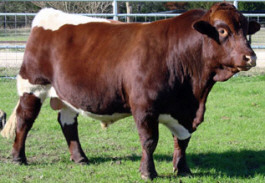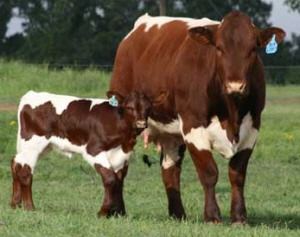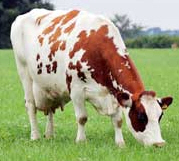



Pinzgauer
History
In Austria 800 BC, Celts first introduced the ancestors of the Pinzgauer to an area called the Hohe Tauern mountain range which is located in today's federal state of Salzburg. As with many breeds of cattle there were many pre-requisites to the breed we know today, these evolved in the valleys of Salzburg such as Tyrol, Carinthia but also in Bavaria and Styria. Some were spotted, some predominantly brown and some black variants too. These colours helped protect and blend in with their environments. Photo courtesy of Texas Circle P Ranch LLC, www.texascirclep.com |
The black and white variant, known as the "lucky cow", survived as an individual animal that every farmer took pride in having. Breeder associations, however, preferred chestnut-coloured animals - as a result, the black Pinzgauer cow has now become very rare. Another specialty is the genetically hornless Pinzgauer breed, known as "Jochberger Hummeln". This genetic variant also has a long tradition. The first record of a hornless calf dates back to 1834 - on the "Hallerwirt" estate in Aurach in the federal state of Tyrol. But in those days, hornless cattle were considered disfigured, because it was impossible to attach a yoke and use them as farm animals. Animals with beautiful horns were much in demand.
As early as 1820, Pinzgauers were exported to the regions that now constitute Romania, Yugoslavia as well as the Czech and Slovak Republics. At the time of the Austro-Hungarian Empire, Pinzgauers were the most common breed of cattle.
In 1856, a collection of Pinzgauers was shown at the world exposition in Paris. The status of Pinzgauer cattle breeding was further enhanced at the world exposition in Vienna in 1873. Particularly popular were three-year-old Pinzgauer draught oxen that had been trained on collars and frontal yokes.
In addition to dairy and meat production, getting the most out of the draught animals was one of the declared breeding targets.
During World War II, Pinzgauer breeders lost their independence and all breeding activities were severely restricted. In 1950, breeders formed an association, the objective was to breed healthy, resilient, robust, fertile, and long-lived cattle that would be fast growing, easy to feed, adaptable, and with great fleshing ability and good milk and work output.
With the increasing use of technology, the breeding target of "work output" subsided, and more attention was given to milk and meat output. Changes to laws on animal breeding between 1965 and 1971 eliminated existing breed restrictions, and the relatively tight primary breeding area of the Pinzgauer cattle was soon weakened by a shift to other cattle breeds. The increasing specialisation of agriculture led to an ever-growing demand for higher milk output. In 1969, therefore, a decision was made to include Red Friesian blood in order to improve milk output, udder shape, and milkability.
However, some breeders in the mountains were quite doubtful of this concept and insisted on pure breeding. There are still considerable Pinzgauer populations to be found overseas, which, except for the Slovak Republic, Romania and Slovenia, are used exclusively for meat production. The Pinzgauer cattle in the Austrian primary breeding area are currently promoted as a high-output, dual-purpose breed. Its broad-based genetic diversity makes it suitable breed for both dairy and meat production.
Characteristics
Pinzgauer cattle are characterised by a dark, chestnut base colour with typical white marks on the back, the flanks and belly as well as on the front legs and calves. Their hair is smooth and the skin is flexible which helps prevent insect infestations. The Pinzgauer has been bred horned and polled.They are a medium to large framed dual purpose breed, but the focus has been predominantly on their beefing qualities.
Mature bulls weigh on average above 2000 lbs and cows 1000 - 1600 lbs. They have sturdy hooves, the ability to travel over long distances and a russet coat which protects them from UV radiation which means Pinzgauer cattle thrive even under the harshest environmental conditions.
On a global scale, Pinzgauer cattle may be classified as beef cattle. Outside of Europe, and for decades, they have been selected for their meat since they were first exported.
Pinzgauer provide good mothering ability and a good milk yield which ensures high weight gain in calves.
Statistics
 Photo courtesy of Texas Circle P Ranch LLC, www.texascirclep.com |
Scientific studies carried out by Prof. Franz Pirchner at the Technical University of Munich attest to the superior quality of Pinzgauer beef - on the basis of both subjective and objective quality criteria. Its marbling, succulence, flavor, and negligible grill losses as well as its fine-fibred quality are among the strong points of Pinzgauer beef.
Comparative
In a bull fattening trial involving 97 animals, the Bavarian dual-purpose breeds Pinzgauer and the middle-framed Original Braun-vieh and Murnau-Werdenfelser were tested for beef performance and meat quality and compared to Bavarian Simmental. The animals were intensively fattened with maize silage and concentrate until they were 500 days old. According to fat classes, large-framed Pinzgauer scored an average of 2.95 points and were thus slightly less adipose than the other breeds. Due to their excellent gross growth rate of 1180g from birth and their good dressing percentage (57.1 %), Pinzgauer nearly equalled Bavarian Simmental (706 g) in carcass weight (345 kg) and net daily gain (688g/day). Because the round showed less distinct muscling, Pinzgauer were, however, graded lower than other breeds by 0.4 to 0.6 EUROP classes. But half a EUROP class corresponds to merely half an Austrian schilling or to 175 schillings per carcass.By Dr. Josef Kögel, Bavaria. Bavarian Institute for Animal Production in Grub, P.O. Box 1180, 85580 Poing
The Pinzgauer distinguished themselves even more with their excellent meat quality.
 Photo courtesy of Bowles Creek Cattle Company, www.bowlescreek.com |
The fact that Pinzgauer beef featured the strongest redness, suggests good meat quality, since good redness signifies that other significant meat quality traits are positive as well.
As of Oct 06 there have been a total 79 Pinzgauer cattle tested for GeneSTAR tenderness markers. 67 animals tested GeneSTAR 2 Stars or better(84.8%) This is better than Angus and Angus-X. Only 1 tested GeneSTAR 0(1.26%) compared to 17% for Hereford
www.pinzgauers.org
Distribution
At present, Pinzgauer cattle can be found in 25 countries around the world. Including South Africa, Canada, the US, and Australia.References (the above information was cited from the following sites)
www.pinzgauer-cattle.com
www.pinzgauers.org
www.texascirclep.com
www.bowlescreek.com
www.ansi.okstate.edu


